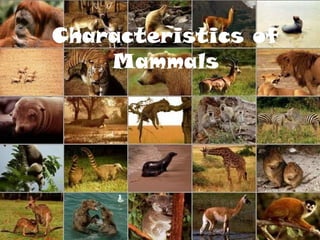
Characteristics of mammals
- 1. Characteristics of Mammals
- 2. The First Mammals • 280 million years ago, reptiles called “therapsids” existed, which had characteristics of both reptiles and mammals • True mammals appeared soon after • They were about the size of mice, were warm blooded, and were able to hunt at night because they could maintain their body temperature
- 3. Common Characteristics • Mammals share 7 characteristics: – 1) Making Milk • All mammals have mammary glands, which are structures that make milk • Only mature females produce milk for their young • All milk is made of sugars, water, proteins, and fats
- 4. – (2) Breathing Air • Mammals use their lungs to get oxygen from the air • Mammals have a muscle to help them get air called a diaphragm it lies at the bottom of the rib cage
- 5. – (3) Endothermic • As oxygen helps break down a mammal’s food, energy is released • This energy keeps a mammal warm • Like birds, mammals are endotherms • Helps them survive in cold areas
- 6. – (4) Hair • Mammals stay warm by having hair • Thick coats are called fur • Most mammals have a layer of fat under their skin to keep them warm • This fat traps heat in the body
- 7. – (5) Specialized Teeth • Mammals have teeth with different shapes and sizes for different jobs • Meat-eating mammals have large canines to help eat prey • Plant-eating mammals have larger incisors and molars to help them bite and grind plants
- 8. – (6) Sexual Reproduction • Most mammals give birth to live young • Newborn mammals stay with at least one parent until they are grown
- 9. – (7) Large Brains • Mammal’s brain is much larger than that of most other animals of the same size • Allows mammals to learn and think quickly • Also allows mammals to respond quickly to events around them • Mammal uses its senses to find out about the world
- 10. Placental Mammals • Placental mammal: embryo develops inside the mother’s body in an organ called a uterus – The placenta attaches the embryo to the uterus – Placenta carries food and oxygen from the mother’s blood to the embryo and carries wastes away from the embryo – The time that the embryo develops is called the gestation period
- 12. • Living placental mammals are divided into 11 main groups that contain 18 orders: – (1) anteaters, armadillos, & sloths • These mammals are called “toothless mammals” but only anteaters have no teeth • Most catch insects with long, sticky tongues
- 13. • Insectivores • Rodents – Eat insects – More than one-third of – Most are small with mammal species are long pointed noses rodents – Include moles, shrews, – Include squirrels, and hedgehogs mice, porcupines
- 14. • Rabbits, Hares, and • Flying Mammals Pikas – Bats are the only – Have sharp, gnawing mammals that fly teeth – Most use echoes to – Have 2 sets of incisors find their food and they in their upper jaw way – Shorter tails than rodents
- 15. • Carnivores • Trunk-Nosed – Have large canine Mammals teeth and special – Elephants are the only molar teeth for slicing living mammals with a meat trunk – Many only eat meat – A trunk is a – Includes bears, cats, combination of an dogs, otters, hyenas upper lip and nose
- 16. • Hoofed Mammals • Cetaceans – A hoof is a thick, hard – All cetaceans live in pad that covers a the water mammal’s toe – Unlike fish, they have – Most hoofed mammals lungs and nurse their are fast runners young – Includes giraffes, – Includes whales, camels, pigs dolphins, and porpoises
- 17. • Manatees and • Primates Dugongs – Have 5 fingers on – Smallest group of each hand and 5 toes mammals that live in on each foot the water – Considered highly – Used their front intelligent animals flippers and tail to – Includes monkeys, swim slowly apes, and humans
- 18. • Monotremes – Mammals that lay eggs – Examples: duck-billed platypus, echidna • Marsupials – Mammals that carry their young in a pouch – Several species of marsupials living today – Examples: koalas, opposum, kangaroo